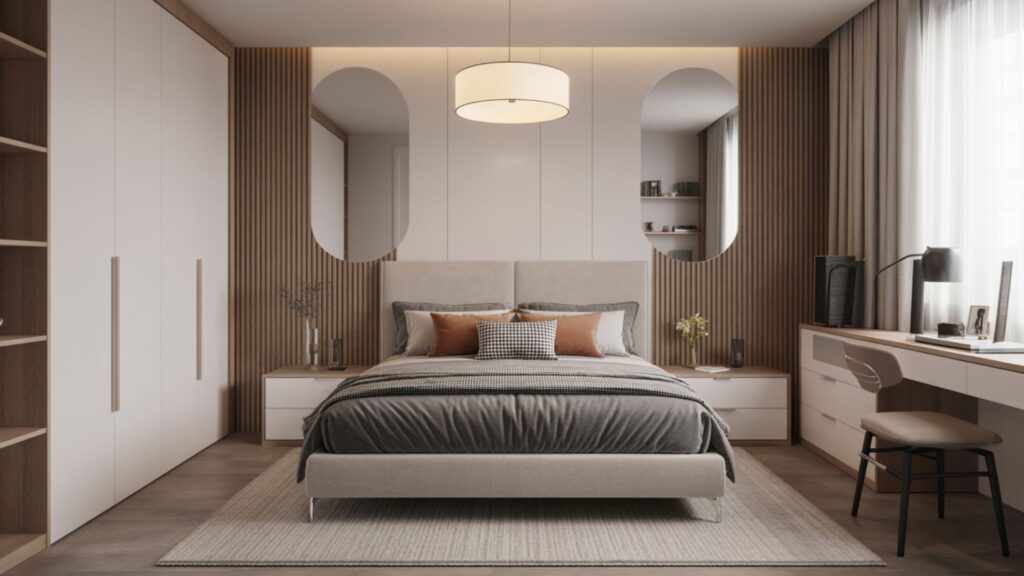I have been, or can be if you click on a link and make a purchase, compensated via a cash payment, gift, or something else of value for writing this post. As an Amazon Associate, I earn from qualifying purchases. Please read my full Affiliate Disclosure for more information.
To audit and upgrade an older bedroom for modern appeal, start by evaluating the Space: map light, airflow, textures, and how each element guides mood and movement. Identify constraints like outlets and doors, then refine layout for safety and flow. Prioritize upgrades that last, choosing durable finishes and timeless silhouettes. Layer lighting, storage, and textures, using a cohesive palette that unifies surfaces. Test samples in natural light, and document decisions as you progress—there’s more to uncover beyond this step.
Key Takeaways
- Assess space character and constraints: measure dimensions, light, airflow, zones, and circulation to guide upgrades.
- Prioritize lasting upgrades: choose durable finishes, timeless silhouettes, and decorative accents that unify the palette.
- Optimize lighting, storage, and layout: layer lighting, add low-profile storage, and test sightlines for smooth routines.
- Select timeless materials and finishes: harmonize window treatments, paint undertones, flooring, and hardware.
- Layer texture and discreet tech: incorporate warm textiles, soft rugs, and hidden outlets or sensors for modern comfort.
Assessing the Space: Understanding Its Character and Conditions
Evaluating the Space: Understanding Its Character and Conditions begins by mapping what’s here and how it behaves. You observe light, airflow, and textures, then note how these elements influence mood and movement. You assess dimensions, ceiling height, and zones for sleeping, dressing, and circulation. Through careful measurement, you identify constraints and opportunities, including outlets, door swings, and acoustic behavior. You consider furniture arrangement to optimize flow and function, ensuring safety and accessibility. You refine a color palette that enhances depth and coherence, aligning with architectural features. This analysis guides precise, purposeful upgrades while preserving character and comfort.
Prioritizing Upgrades: Impactful Changes That Last
After evaluating the space and its behavior, you’re ready to light a clear path forward: prioritize upgrades that deliver meaningful impact with lasting value. You’ll focus on thoughtful choices, not trends, ensuring each change reinforces atmosphere and function.
- Choose decorative accents that unify color schemes and add tactile interest
- Select durable materials and finishes that age gracefully
- Prioritize timeless silhouettes over fads for long-term appeal
- Plan a cohesive palette with contrast, balance, and subtle drama
This approach honors craft, reduces future upgrades, and creates a serene, enduring retreat.
Lighting, Storage, and Layout: Practical Refreshes

Lighting, storage, and layout aren’t separate tactics here—they’re a unified system that reshapes how you move through the room. You’ll align light layers with purposeful shelves and a smart furniture grid, so every step feels intentional. Start with task lighting near desks or reading nooks, then soften atmosphere with ambient fixtures and decorative accents that reflect your color palettes. Optimize storage by pairing low-profile units with vertical display zones, keeping surfaces clear for focus. Measure sightlines, ensure symmetry where desired, and test flow during daily routines. This methodical refresh cultivates clarity, rhythm, and a modern, breathable bedroom.
Materials and Finishes: Choosing Timeless Complements
Materials and finishes aren’t just surface choices—they’re the quiet framework that grounds the room’s character. You approach this with purpose, selecting timeless complements that endure beyond trends. Your goal is balance, texture, and light interplay, guided by smart constraints and honest assessment.
- window treatments that soften daylight while preserving sightlines
- paint palettes built on harmony, not glare
- flooring tones that anchor furniture with warmth
- trim and hardware that unify cabinetry, doors, and casework
You’ll test samples in natural light, compare undertones, and document how each choice affects mood, scale, and energy. The result is cohesive, enduring elegance.
Layering Texture and Tech: Finishing Details for Modern Comfort
Layering texture and technology into a bedroom isn’t about adding noise; it’s about crafting tactile depth that enhances comfort while supporting modern living. You balance material contrast and sleek devices, so each element serves purpose. Start with wall decor that anchors color and mood without overpowering lines. Layer textures—woven fabrics, soft rugs, matte surfaces—to create warmth and sound dampening. Integrate tech gracefully: hidden outlets, ambient lighting, and quiet sensors that respect routines. Choose color schemes that unite surfaces, textiles, and screens. Finally, document decisions, refine contrasts, and guarantee maintenance remains straightforward for lasting comfort and clarity.
Conclusion
You’ll close the loop by treating the room as a living system: audit, then refine. you’ll map its quirks, prioritize upgrades that endure, and weave light, storage, and layout into a single, cohesive rhythm. choose timeless materials, layer texture with careful restraint, and tuck in subtle tech that boosts ease rather than distraction. approach each detail methodically, envisioning long-term comfort, daily delight, and a space that grows with you—quiet, resilient, and endlessly adaptable.

Leave a Reply